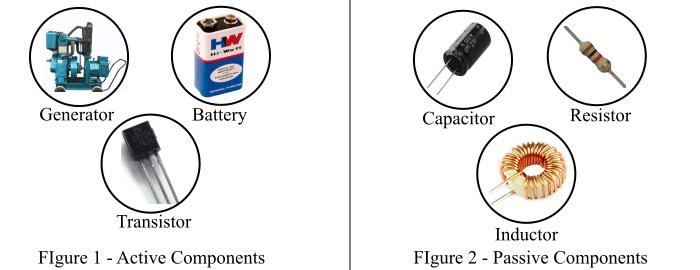
 Data Structure
Data Structure Networking
Networking RDBMS
RDBMS Operating System
Operating System Java
Java MS Excel
MS Excel iOS
iOS HTML
HTML CSS
CSS Android
Android Python
Python C Programming
C Programming C++
C++ C#
C# MongoDB
MongoDB MySQL
MySQL Javascript
Javascript PHP
PHP
- Selected Reading
- UPSC IAS Exams Notes
- Developer's Best Practices
- Questions and Answers
- Effective Resume Writing
- HR Interview Questions
- Computer Glossary
- Who is Who
Difference between Active and Passive Components (in Electronics)
In electrical and electronics engineering, the closed path followed by the electric current is known as electric circuit. Every electric circuit is composed of many circuit components such as sources of power, resistors, capacitors, inductors, diode, etc. Therefore, the circuit components are the basic building blocks of an electrical or electronic circuit.
Depending upon the power delivering or absorbing ability, the circuit components can be classified in following two types
Active components
Passive components
The most significant difference between active components and passive components is that an active component can supply power to an electric circuit, whereas a passive component cannot deliver power, it can only absorb the power in the circuit.

This article is meant for explaining the major differences between active components and passive components. Also, we have briefly described the active and passive components which makes the understanding of differences easier.
What is an Active Component?
An electric circuit element which can supply electric power to the circuit or power gain in the circuit, is known as an active element or active component.
Some common examples of active circuit elements are energy sources (voltage sources or current sources), generators or alternators, semiconductor devices such as transistors, photodiodes, etc.
The active elements are the circuit component which are entirely responsible for the flow of electric current in the circuit.
What is a Passive Component?
The circuit element which can only absorb electrical energy and dissipates it in the form of heat or stores in either magnetic field or electric field is known as passive circuit component or simply passive component.
Therefore, a passive component cannot provide electric power or power amplification in an electric circuit. Some common examples of passive circuit components are resistor, inductor, capacitor and transformer, etc.
Difference between Active and Passive Components
Both active and passive elements are the main parts of an electrical or electronic circuit. However, they are different from each other in many aspects. All the noticeable differences between active and passive circuit elements are enlisted in the following table.
Basis of Difference |
Active Component |
Passive Component |
|---|---|---|
Definition |
A circuit component which can deliver power or power gain in an electric circuit for infinite duration of time is known as active component. | A circuit element which only absorbs the power and convert it in heat or stores in electric field or magnetic field is known as passive component. |
Examples |
The common examples of active components are energy sources (voltage or current source), generators, semiconductor devices like transistors, solar cells, SCR, etc. | The examples of passive components are resistor, inductor, capacitor and transformer, etc. |
Role in the circuit |
Active components behave as source of power in the circuit. | The passive components act as load in the circuit. |
Power gain |
Active components can provide power gain in the electric circuit. | Passive components cannot provide power gain. |
Function |
Active components receive energy in the forms such as thermal energy, chemical energy, hydraulic energy, etc. and delivers in the circuit in the form of electrical energy. | Passive components receive electrical energy and either convert it in the other forms such as heat, light, rotation, etc. or store in the magnetic field or electric field. |
Control of current flow |
Active components cause current flow in the circuit and control the flow of current. | The passive components cannot control the current flow in the circuit. |
Slope of VI graph |
The slope of VI characteristics curve (i.e. ratio of voltage to the current) of an active element is negative. | The slope of VI characteristics curve (i.e. the ratio of voltage to current) of a passive component is positive at all the points. |
Quadrant of graph |
For an active element, the VI curve lies in the 2nd and 4th quadrant. | The VI curve of the passive elements lies in the 1st and 3rd quadrant. |
Power deliver or absorb |
Active components can deliver as well as absorb the electrical power. For example, a battery, during charging absorbs electrical energy and during discharging delivers electrical energy. | A passive element can only absorb electrical power. It is not capable for deliver power. |
Need of external power source to function |
Some active components require an external power source to function. For example, the active components like transistors and SCR use electrical energy to function, i.e., to control the power in the circuit. | Passive components do not require any external power source to function. The passive components such as resistor, inductor, capacitor, etc. do not require any source of electricity to function, they use some other property to control the power in the circuit. |
Amplification |
Active components have power gain more than unity, so they can amplify a signal. | For passive components, the power gain is less than unity, hence they cannot amplify a signal. |
Conclusion
In this post, we have differentiated the active and passive components by considering various parameters such as basic definition, function, power gain or amplification, current flow, components role in the circuit, etc. Both active and passive components are the most basic elements of an electrical or electronic circuit.

